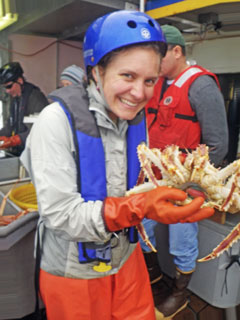Current research projects
- Environmental effects on Briarosaccus callosus larvae Parasites can represent a significant stressor in crustacean populations, and render previously healthy stocks unable to recover from fishing pressures. Very little is known about king crab parasites or their effects on fisheries, but it has been suggested that a compilation of parasites may have played a role in the ten-fold decline in Bristol Bay red king crab commercial catch in the 1980s. The parasitic (rhizocephalan) barnacle Briarosaccus callosus can infect all commercially-harvested Alaskan king crab species. Once infected the crabs are transformed into “zombie crabs”. In other words, the parasite does not kill its crab host, but reduces it to no more than a body that is controlled by the parasite. Infected crabs can no longer reproduce
- instead they raise and care for the eggs and larvae of the parasite. Rhizocephalan barnacles do not look anything like their relatives that live on rocks and sides of ships. Instead these parasites live inside crabs and their bodies consist of branching green strings (interna)(Fig. 1a). The parasite’s egg sac (externa) is located under the abdomen (Fig. 1b) of the host and takes the place of the host’s own egg mass. Prevalence and distribution of B. callosus is poorly understood. Most records indicate a low level prevalence (< 1% of crabs infected) throughout Alaskan king crab populations. However, outbreaks have occurred where over 75% of king crabs were infected. Outbreaks at this level will greatly reduce reproductive output in king crab populations and likely lead to population declines. Causes of variability in B. callosus prevalence have not been identified. There is some evidence that warmer water temperatures may increase survival of B. callosus larvae. Due to climate change, increased water temperatures are expected in the Arctic and sub-Arctic, suggesting that B. callosus could increase in prevalence, harming king crab stocks. I am examining the effects of temperature and salinity on survival of B. callosus larvae to help determine whether or not climate change-induced warming will lead to a higher abundance of castrated “zombie crabs” and a decline in fecundity of king crab populations.
- What makes a king crab a zombie crab Parasitic barnacles can influence the behavior and morphology of host crabs to favor the production of their own larvae. For example, infected crabs will groom the parasite’s externa as if it was their own egg sac, and pump their abdomens to assist with parasite larval release. In addition, many rhizocephalan species cause feminization of male crabs. Despite the physiological, morphological, and behavioral changes these parasites cause in the host, no one has ever determined how the parasite “takes control” of its host and manipulates its behavior. To manage the detrimental effects of B. callosus on king crab fisheries and the people who depend on them, we need to understand how these parasites are gaining control of their hosts and the susceptibility of host populations. Metabolomics is a newly emerging technique that allows for the simultaneous measurement of hundreds of metabolites. Metabolites are low molecular weight molecules (e.g., hormones), which respond quickly to changes within the body. As a result of this rapid response, metabolomics is a useful technique to identify how a body reacts to foreign substances, such as toxins, pharmaceuticals, or disease. I will compare the metabolite profiles of infected and non-infected king crabs to determine how B. callosus changes the physiology of its host. Hormones that differ will help elucidate how the parasite controls, castrates, and feminizes its host. Metabolomics will also help identify if there is an immune response from the host crabs.
- Daily Fishing Logs Spatial distribution of fisheries species must be well characterized in order to avoid local depletions during fishing seasons, and to identify closure areas that minimize bycatch in other fisheries. The Bristol Bay red king crab fishery is one of the largest crab fisheries in Alaska. Despite its size, we lack essential information about king crab distributions when the fishery is open in the fall and winter, although summer distributions are known from surveys. Concerns over shifting distributions of king crabs recently motivated the North Pacific Fisheries Management Council (NPFMC) to examine the effectiveness of the current red king crab protection areas in Bristol Bay. However, since most bycatch of king crabs occurs in the winter and we lack winter distribution data, it is impossible to accurately evaluate the placement of crab protection areas. Daily fishing logs (DFL), kept by skippers since 2005, may be able to provide these data, for they contain detailed information on location and catch. Unfortunately, logs are hand-written and have never been digitized
- thus, the information is not readily accessible. I will digitize DFL data from the Bristol Bay red king crab fishery. Catch and effort will be used to elucidate crab distributions, providing insight into fall and winter distributions that can be compared with summer distributions well-known from trawl surveys. In addition, I will analyze these data to determine how competition has changed within the fishery since rationalization. When the fishery was rationalized in 2005, fishing practices changed from the highly competitive “race for fish” approach to the more relaxed quota system. In the former, the fishing season lasted only a few days, whereas under the new system, each vessel has three months to fulfill its quota. The fleet thus had to change strategies dramatically to adapt to the new system.
Affiliations
- The Crustacean Society
- American Fisheries Society AK chapter



